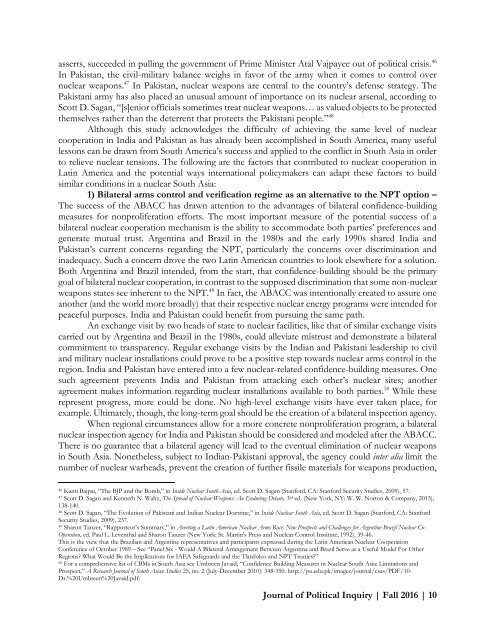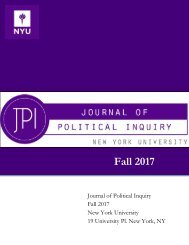Fall2016_Final2
You also want an ePaper? Increase the reach of your titles
YUMPU automatically turns print PDFs into web optimized ePapers that Google loves.
asserts, succeeded in pulling the government of Prime Minister Atal Vajpayee out of political crisis. 46<br />
In Pakistan, the civil-military balance weighs in favor of the army when it comes to control over<br />
nuclear weapons. 47 In Pakistan, nuclear weapons are central to the country’s defense strategy. The<br />
Pakistani army has also placed an unusual amount of importance on its nuclear arsenal, according to<br />
Scott D. Sagan, “[s]enior officials sometimes treat nuclear weapons… as valued objects to be protected<br />
themselves rather than the deterrent that protects the Pakistani people.” 48<br />
Although this study acknowledges the difficulty of achieving the same level of nuclear<br />
cooperation in India and Pakistan as has already been accomplished in South America, many useful<br />
lessons can be drawn from South America’s success and applied to the conflict in South Asia in order<br />
to relieve nuclear tensions. The following are the factors that contributed to nuclear cooperation in<br />
Latin America and the potential ways international policymakers can adapt these factors to build<br />
similar conditions in a nuclear South Asia:<br />
1) Bilateral arms control and verification regime as an alternative to the NPT option –<br />
The success of the ABACC has drawn attention to the advantages of bilateral confidence-building<br />
measures for nonproliferation efforts. The most important measure of the potential success of a<br />
bilateral nuclear cooperation mechanism is the ability to accommodate both parties’ preferences and<br />
generate mutual trust. Argentina and Brazil in the 1980s and the early 1990s shared India and<br />
Pakistan’s current concerns regarding the NPT, particularly the concerns over discrimination and<br />
inadequacy. Such a concern drove the two Latin American countries to look elsewhere for a solution.<br />
Both Argentina and Brazil intended, from the start, that confidence-building should be the primary<br />
goal of bilateral nuclear cooperation, in contrast to the supposed discrimination that some non-nuclear<br />
weapons states see inherent to the NPT. 49 In fact, the ABACC was intentionally created to assure one<br />
another (and the world more broadly) that their respective nuclear energy programs were intended for<br />
peaceful purposes. India and Pakistan could benefit from pursuing the same path.<br />
An exchange visit by two heads of state to nuclear facilities, like that of similar exchange visits<br />
carried out by Argentina and Brazil in the 1980s, could alleviate mistrust and demonstrate a bilateral<br />
commitment to transparency. Regular exchange visits by the Indian and Pakistani leadership to civil<br />
and military nuclear installations could prove to be a positive step towards nuclear arms control in the<br />
region. India and Pakistan have entered into a few nuclear-related confidence-building measures. One<br />
such agreement prevents India and Pakistan from attacking each other’s nuclear sites; another<br />
agreement makes information regarding nuclear installations available to both parties. 50 While these<br />
represent progress, more could be done. No high-level exchange visits have ever taken place, for<br />
example. Ultimately, though, the long-term goal should be the creation of a bilateral inspection agency.<br />
When regional circumstances allow for a more concrete nonproliferation program, a bilateral<br />
nuclear inspection agency for India and Pakistan should be considered and modeled after the ABACC.<br />
There is no guarantee that a bilateral agency will lead to the eventual elimination of nuclear weapons<br />
in South Asia. Nonetheless, subject to Indian-Pakistani approval, the agency could inter alia limit the<br />
number of nuclear warheads, prevent the creation of further fissile materials for weapons production,<br />
46<br />
Kanti Bajpai, “The BJP and the Bomb,” in Inside Nuclear South Asia, ed. Scott D. Sagan (Stanford, CA: Stanford Security Studies, 2009), 57.<br />
47<br />
Scott D. Sagan and Kenneth N. Waltz, The Spread of Nuclear Weapons: An Enduring Debate, 3 rd ed. (New York, NY: W. W. Norton & Company, 2013),<br />
138-140.<br />
48<br />
Scott D. Sagan, “The Evolution of Pakistani and Indian Nuclear Doctrine,” in Inside Nuclear South Asia, ed. Scott D. Sagan (Stanford, CA: Stanford<br />
Security Studies, 2009), 237.<br />
49<br />
Sharon Tanzer, “Rapporteur’s Summary,” in Averting a Latin American Nuclear Arms Race: New Prospects and Challenges for Argentine-Brazil Nuclear Co-<br />
Operation, ed. Paul L. Leventhal and Sharon Tanzer (New York: St. Martin's Press and Nuclear Control Institute, 1992), 39-46.<br />
This is the view that the Brazilian and Argentine representatives and participants expressed during the Latin American Nuclear Cooperation<br />
Conference of October 1989 – See “Panel Six - Would A Bilateral Arrangement Between Argentina and Brazil Serve as a Useful Model For Other<br />
Regions? What Would Be the Implications for IAEA Safeguards and the Tlatelolco and NPT Treaties?”<br />
50<br />
For a comprehensive list of CBMs in South Asia see Umbreen Javaid, “Confidence Building Measures in Nuclear South Asia: Limitations and<br />
Prospect,” A Research Journal of South Asian Studies 25, no. 2 (July-December 2010): 348-350. http://pu.edu.pk/images/journal/csas/PDF/10-<br />
Dr.%20Umbreen%20Javaid.pdf.<br />
Journal of Political Inquiry | Fall 2016 | 10
















